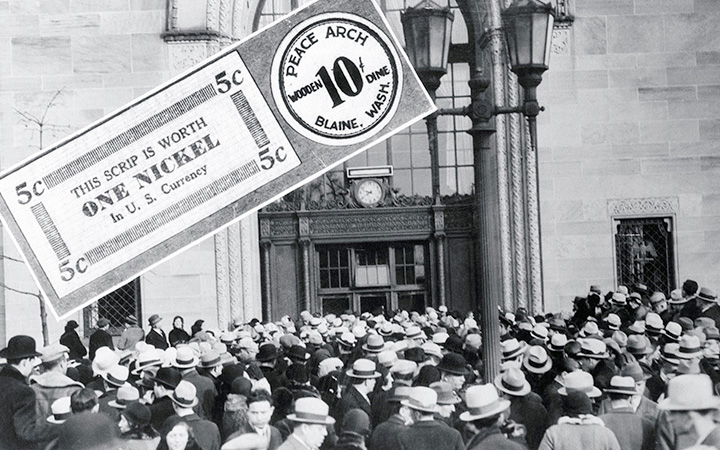
Global Banking Crisis: Turmoil, Risks, and Opportunities
Unraveling the Financial Sector Meltdown: From Market Jitters to Systemic Risks and Potential Silver Linings
The recent global financial turbulence has set the stage for a precipitous fall in banking stocks, affecting the market capitalization of banks worldwide. The persistent downtrend in the shares of various lenders, as they nosedived for the fourth consecutive week, has left investors with a sense of trepidation. This fear has led to a withdrawal of approximately $2.1 billion from financial stocks in the week ending May 10, as per reports from Bank of America Corp. strategists who were relying on EPFR Global data.
Exchange-traded funds that concentrated on this sector also observed the most significant cash outflow since September. This was further corroborated by Refinitiv Lipper data. The Financial Select Sector SPDR Fund, boasting a hefty $29 billion, experienced a substantial outflow of over $2 billion within a span of two weeks.
This financial exodus carries with it a potential extension of the ongoing market chaos instigated by the collapse of Silicon Valley Bank, among other lenders, over the past two months. This sequence of bank failures has exacerbated anxieties over a potential chain reaction in the banking sector, fueled by rising costs and escalating losses, which is a direct fallout from the Federal Reserve's forceful interest-rate hikes over the past decade that have sent shockwaves through the economy.
The market volatility has been a boon for short sellers, who have seized the opportunity to profit from falling stocks. Regional banks have been hit hard, becoming some of the most severe casualties of this year's stock market slump. Western Alliance Bancorp, Zions Bancorp, Comerica, and KeyCorp have all seen their stock values plummet by at least 50% since the onset of March. The S&P 500's worst-performing companies this year include eight from the financial sector.
Ben Gerlinger, an analyst from Hovde Group, has consistently argued against the rationale behind Western Alliance's stock decline, asserting that the bank is more robust than its competitors. Nevertheless, the trading dynamics have adopted a herd mentality, resulting in investors shunning bank stocks. Gerlinger believes, though, that the fear of bank runs is largely overblown. The data, according to him, indicates that deposit outflows for regional banks have been relatively subdued.
Federal regulators, including Federal Reserve Chair Jerome Powell, have attempted to restore faith in the nation's banking system. Powell reassured the public that the banking system remains "sound and resilient," despite the forced seizure and subsequent sale of First Republic to JPMorgan Chase & Co. However, this assurance has done little to allay investor anxieties.
Banks are grappling with a slew of pressures: rising deposit rates designed to curb the cash exodus to higher-yielding money-market funds, mark-to-market losses on assets, and the prospect of defaulting small business and commercial real estate loans if the economy contracts and high office vacancies persist.
The early days of this turmoil in March had seen investors seeking to make a quick buck by buying on the dips, a strategy that had paid off handsomely during the bull market of the pandemic. The Financial Select Sector SPDR Fund managed to attract around $1.2 billion in one week in mid-March. However, as bank stocks failed to rebound, these ventures proved ill-fated and left investors reluctant to try their luck again.
Over the past couple of months, the SPDR S&P Regional Banking ETF has recorded daily declines of at least 5% on six separate occasions. An analysis by Bespoke Investment Group reveals a median decline of 2% in the weeks following these drops. The KBW Bank Index, which tracks 21 lending institutions, has plunged by over 33% since the beginning of March.
In response to this downturn, regional bank stocks have become significantly undervalued,
trading at their lowest levels relative to the S&P 500 in more than two decades, according to Bloomberg data. However, the high potential for further losses has deterred many investors from capitalizing on these seemingly attractive valuations.
The market turbulence has also drawn the attention of global financial regulators, who have urged banks to exercise greater caution and vigilance. The Basel Committee on Banking Supervision recently issued a warning about the potential for a "contagion effect" from the American banking crisis, which could potentially destabilize the global financial system. The Committee urged banks to maintain robust risk management practices and ensure adequate capital buffers to absorb potential losses.
Federal Reserve officials have also called for tougher regulatory measures, including stricter oversight of bank lending practices and capital requirements. This has been viewed as a necessary step to prevent a repeat of the 2008 financial crisis when lax lending standards and excessive risk-taking by banks contributed significantly to the housing market crash and subsequent recession.
The Federal Reserve's recent stress tests on banks, designed to evaluate their ability to withstand a severe economic downturn, have also become a focal point in the ongoing debate about the health of the banking sector. While most banks passed the stress tests, a few, including Western Alliance Bancorp and Zions Bancorp, fell short of the minimum capital requirements, further intensifying concerns about their financial stability.
In the face of this market volatility, some financial institutions have made strategic moves to strengthen their positions. JPMorgan Chase & Co., for example, recently acquired First Republic in a government-assisted deal, extending its foothold in the high-net-worth and ultra-high-net-worth client segments.
In contrast, other banks have opted to streamline their operations, shedding non-core businesses and cutting costs to improve their financial performance. Wells Fargo & Co. recently announced a plan to sell its corporate trust services business as part of a broader strategy to focus on its core banking operations.
While the tumultuous state of the banking sector continues to instill fear in investors and has undoubtedly caused significant financial distress for many banks, it also presents opportunities for those with the foresight and courage to navigate these turbulent waters. As in any crisis, there will be winners and losers. The ability to discern which banks will be able to weather the storm and emerge stronger will be key to making sound investment decisions in the coming months.
As we move forward, the banking industry's fate will be influenced by various factors, including the trajectory of interest rates, the pace of economic recovery, and the effectiveness of regulatory measures aimed at preventing a full-blown banking crisis. Therefore, investors, regulators, and other stakeholders will need to keep a close eye on these evolving dynamics as they navigate the uncertain landscape of the global banking sector.
Read More
-
Pagaya Stock Price Forecast - PGY at $23.20: Is PGY Stock the Cheapest AI Fintech of 2026?
19.12.2025 · TradingNEWS ArchiveStocks
-
XRP Price Forecast: XRP-USD Stuck at $1.87 With $3 2026 Target and $10–$25 Long-Term Range
19.12.2025 · TradingNEWS ArchiveCrypto
-
Oil Price Forecast: WTI Near $56 and Brent at $60 Signal Risk Toward $50
19.12.2025 · TradingNEWS ArchiveCommodities
-
Stock Market Today: AI Chip Rally Lifts Nasdaq as $7.1T Quad Witching Hits
19.12.2025 · TradingNEWS ArchiveMarkets
-
GBP/USD Price Forecast - Pound at 1.34 As BoE Cut And Soft Dollar Keep Bullish Path Toward 1.35
19.12.2025 · TradingNEWS ArchiveForex


















